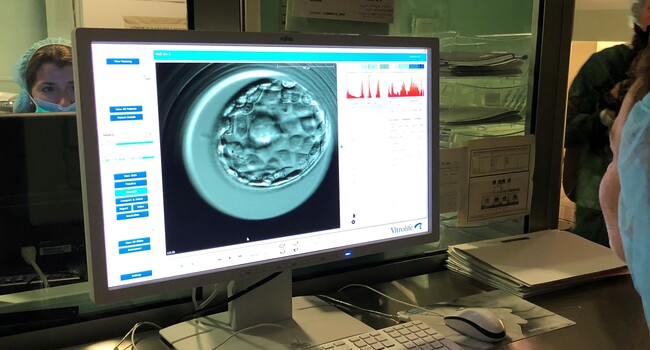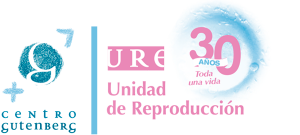Frozen embryo transfer: frequently asked questions about this assisted reproduction treatment

The frozen embryo transfer is a treatment we perform at our fertility clinic in Spain in cases where we were able to freeze embryos that were previously created in a cycle of in vitro fertilisation treatment, regardless of whether the embryos were made using own eggs or donor eggs (egg donation).
When IVF or egg donation treatment is indicated we must try to carry out treatment as efficiently as possible. This means that we will stimulate the ovaries to obtain enough eggs so that the patient has a good chance of conceiving, as not all eggs will be mature, not all will fertilise and not all embryos will have optimal quality for transfer.
The goal throughout this process is to have one or two good quality embryos for transfer. However, the procedure is sometimes very effective and we obtain extra good quality embryos in addition to the ones to be transferred. In these cases we will cryopreserve the additional embryos through ultra-rapid freezing, or vitrification.
Embryo cryopreservation is a fundamental tool that not only benefits couples who weren’t able to conceive following their fresh treatment, but also for couples who wish to return for a second child in the future. Embryo cryopreservation is also utilised in cases where, for medical reasons, a fresh embryo transfer is not advisable, like for example in patients at risk for ovarian hyper-stimulation, inadequate endometrial preparation, etc. In these cases we can postpone the embryo transfer and the embryos will remain frozen in our embryo bank until the medical reason which prevented the embryo transfer from taking place no longer exists.
In order to help you understand this procedure we have prepared this article, throughout which we want to answer all the questions that future mums tend to ask us when they are going to start this process with us.
What is the preparation like for a frozen embryo transfer cycle?
The cryotransfer is straightforward and affordable as it does not involve the same preparation as the in vitro fertilisation cycle which requires daily injections, sedation, operating theatre, etc.
This treatment consists of the endometrial preparation to receive the embryos. There are two options for the endometrial preparation: natural cycle preparation or a stimulated cycle involving constant administration of the hormones oestradiol and progesterone.
Both endometrial preparation methods have proven to be equally effective when it comes to the results. For this reason, at URE Centro Gutenberg the decision to use one method over another will depend exclusively on medical criteria and patient comfort and wellbeing.
What day is the frozen embryo transfer carried out?
There must be coordination and communication between the embryo and the endometrium. In order for these two things to exist, the number of days of embryo development must be the same as the number of days of endometrial development post-ovulation.
In other words, a day‑5 embryo must be transferred five days after ovulation supposedly took place, on the fifth day of treatment with progesterone.
What’s better: a fresh or a frozen embryo transfer?
Nowadays, utilising frozen embryos from a cycle of in vitro fertilisation practically offers the same chances of pregnancy as a fresh embryo transfer.
In fact, there are an increasing number of studies which demonstrate comparable success rates between fresh and frozen embryo transfers. There are even authors who have found that there is a higher likelihood of achieving a pregnancy using frozen embryos.
When will the cryopreserved embryos be thawed?
The embryologists will thaw the embryos first thing in the morning on the same day as the embryo transfer. Afterward, they will inform the patient about how the thawing process went and will tell them what time to come to the clinic for their big moment. There must be at least two hours between embryo thawing and embryo transfer so that there is enough time to observe embryo development and to get rid of any remaining medium in which the embryo was cryopreserved.
In the past, embryo culture to blastocyst stage was not standardised and the majority of transfers and cryopreservation procedures were performed on day three of embryo development. Now, thanks to all the advances in culture media, these procedures are carried out on day five or six of embryo development. If you were a patient in the past and you have embryos that were frozen on day +3, we would thaw your embryo and the transfer would take place two or three days later in blastocyst stage.
What is the survival rate of embryos after thawing?
A successful thawing or warming procedure will depend on embryo quality at the time the embryos were originally cryopreserved as well as their ability to survive the processes of freezing and thawing.
The difference is clear when it comes to comparing embryos that came from a cycle of in vitro fertilisation with own eggs compared to IVF with donor eggs, or egg donation. The survival rate is 97% in cases where the embryos come from an egg donation cycle, and 90% when the embryos come from a cycle of IVF with own eggs.
Have we answered all your questions about frozen embryo transfer? Remember that at URE Centro Gutenberg we’re here to help you. If you need more information, contact us, we will be happy to assist you!.

